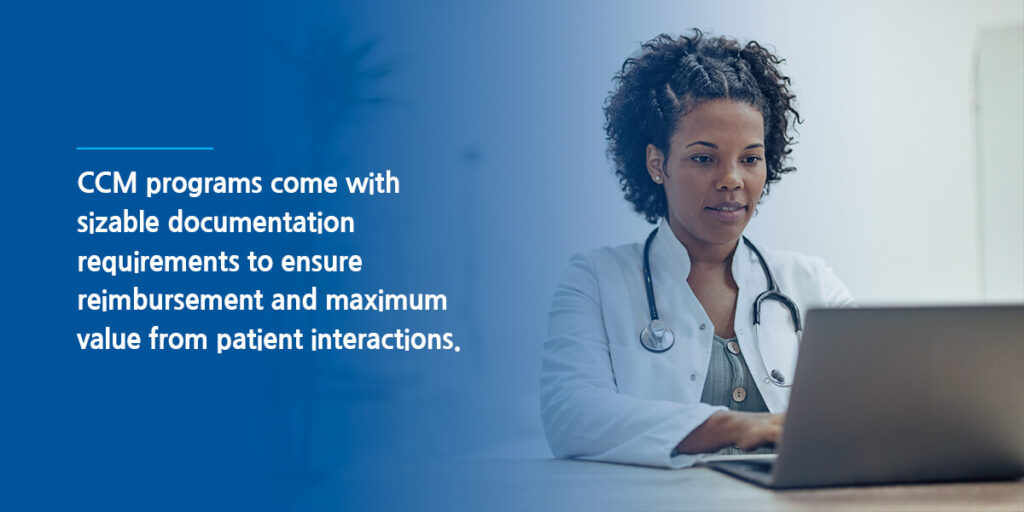How to Implement a Chronic Care Management Program
Chronic care management (CCM) is a powerful way to support your patients with chronic conditions long after they leave the doctor’s office. It allows them to easily communicate with care teams and receive individualized, ongoing care plans, all through a convenient remote service. The practice also benefits, using this value-based care to help patients manage their conditions and save on costs through reimbursement from the Centers for Medicare & Medicaid Services (CMS).
Taking full advantage of these programs calls for some preparation. Many practices dive into offering a CCM service without fully understanding CCM requirements. They may end up struggling with various aspects, like staffing, training or documentation. While CCM programs offer significant benefits, poor implementation practices can cause them to fail.
Why Do Some CCM Implementations Fail?
CCM programs may sound straightforward on the surface, but you need to coordinate many different aspects to make sure yours is sustainable and works well within the practice. From the size of your staff to your documentation methods, make sure you’ve addressed the following elements before embarking on your chronic care management program:
1. Staff Size
One common mistake practices make is not maintaining an appropriately sized staff to run the CCM program. Without enough people, CCM can quickly overburden your skilled professionals. CMS requires care managers to be one of the following:
- Practitioner
- Registered nurse (RN)
- Licensed practical nurse (LPN)
- Certified medical assistant (CMA)
- In some areas, a health coach
These professionals will be spending a minimum of 20 minutes per month with each patient. Depending on the size of the practice, this will likely require a full-time position, if not multiple. Putting that workload on staff members who already have other jobs to do can increase frustration for them and lead to poorer quality of care.
Having enough staff available to run the program is critical to the success of a chronic care management plan. If you don’t think you can manage the staffing requirements, outsourced service providers can serve as an extension of your practice and help you meet staffing demands. We’ll discuss outsourcing in more detail later, but know that it often makes CCM possible for practices that may not have the capacity for an in-house team.
2. Number of Qualifying Patients
Of course, you’ll need enough patients to make the program worthwhile. According to CMS, qualifying patients are those with multiple chronic conditions that are expected to last at least 12 months or until the death of the patient. These conditions must also place the patient at significant risk of acute exacerbation/decompensation, death or functional decline.
The Chronic Conditions Data Warehouse (CCW) worked with CMS to create a list of conditions. These include conditions like diabetes, hypertension, cancers and chronic kidney disease. Other categories include mental health problems like depression and anxiety disorders and potentially disabling conditions like traumatic brain injuries, cerebral palsy or mobility impairments.
Many patients meet the criteria for CCM. About 30% of American adults have multiple chronic conditions, but that number jumps significantly for older adults. As many as 76.9% of Medicare and/or Medicaid recipients 65 and older have multiple chronic conditions. Depending on your practice’s demographics, you may have a sizable portion of patients that qualify for the program.
Still, some practices don’t perform this research beforehand and find their enrollment numbers misaligned with the scope of the CCM program’s design. You could also have an issue with marketing. If the program isn’t well-advertised to potential members, enrollment numbers may be insufficient. One way to look for new patients is to use your CCM alongside your electronic health record (EHR). You can look for specific diagnoses and encourage enrollment for patients who qualify.
3. Patient Churn
Patients will continuously move in and out of your practice and Medicare itself. To establish a sustainable program, you’ll need a plan for managing churn. This includes enrolling new patients to offset those who exit the program and delivering top-tier service to retain your current members.
Many practices address patient churn through reporting tools and insights. These can help you focus on continuous improvement, assessing strengths and weaknesses to ensure sustained membership and high satisfaction rates. You can also invest in marketing efforts, such as properly identifying potential new enrollees and making the process simple for them.
4. Program Requirements
Understanding how to meet CMS guidelines is a significant part of ensuring your program has the funding it needs. In addition to meeting the multiple-conditions requirement discussed above, the requirements for non-complex CCM under code 99490 include:
- A personalized care plan in a certified EHR, with a copy given to the patient
- Verbal or signed patient consent
- 24/7 patient access to a care team member
- Care transitions management
- Enhanced non-face-to-face communication between the care team and the patient
- A minimum of 20 minutes (complex services require 60 minutes) of clinical staff time per calendar month of non-face-to-face services directed by a physician or other qualified professional
Fully understanding these requirements can help you take steps to ease the billing process, improve documentation, limit audit issues and increase the overall efficacy of the program. For example, you could implement a software program like TimeDoc Health that delivers tools for tracking monthly encounters, storing patient consent and care forms and streamlining reporting. An outsourced provider who specializes in CCM can help ensure nothing slips through the cracks.
5. Lack of Leadership and Intervention Champions
Researchers have found that a lack of support and accountability from senior leadership makes it more challenging to execute intervention processes. If a practice’s leaders are committed to the intervention, buy-in can reach all levels of the organization, delivering appropriate resource distribution for more effective implementation. Intervention “champions” can also play a significant role in helping healthcare providers endorse CCM initiatives.
Both are significant components of organizational readiness for CCM implementation.
6. Lack of Staff Buy-In
Practices may also overlook the interest of their providers. The same study mentioned above found that provider buy-in was greatly influenced by the provider’s beliefs and knowledge of the intervention, including:
- Misconceptions
- Skepticism about the program’s efficacy
- Lack of information
Proper training and plenty of information about the benefits of CCM can clear up some common problems that practices face regarding provider buy-in. The program itself also needs to be agreeable to a clinician’s workflow. If it significantly increases their workload, requires them to learn a new piece of software or otherwise adds frustration to their day, they’ll likely be unengaged. Help providers stay invested in CCM with an easy-to-use system that offers clearly beneficial tools.
7. Lack of Resources
Practices need appropriate resources to meet patient needs and maintain staff buy-in. These resources include staffing, funding and a strong software solution. Without the right tools, staff might struggle to meet demands or introduce more errors to the workflow.
A lack of resources often stems from poor leadership support, which can affect funding and staff allocation. Before launching a CCM program, you’ll need to solidify access to appropriate resources. This is another area where outsourcing can prove especially valuable, delivering all of the resources needed in one convenient service.
8. Documentation
Many practices don’t consider how their CCM program will affect documentation practices or vice versa. With strong documentation, you can reduce errors and improve efficiency, freeing up staff for clinical tasks. Documentation needs to be exact to ensure proper reimbursement and accuracy in the event of an audit.
There are several ways to achieve accuracy and efficiency, such as automating certain parts of your documentation strategy and ensuring comprehensive, secure recordkeeping in the cloud. You might automate manual tasks like claiming reimbursements or documenting care.
TimeDoc Health can automate care planning with templates and synchronize encounters with your EHR. Minimizing repetitive or unnecessary work frees up more time for patient care and can create a more efficient approach to CCM.
Take some time to evaluate your documentation practices, ensuring they strengthen your CCM program rather than detract from it.
Tips for Successful CCM Plans
When it’s time to plan for and implement your CCM program, the following strategies can ease the process and help ensure success:
1. Consider Outsourcing Your CCM
It can be tempting to add the workload of a CCM to your existing team, but many practices underestimate the extent of the work required for running a CCM program. Depending on the size of your practice, you’ll likely need to hire one or more care managers to drive the program and complete tasks like engaging with patients and coordinating treatments.
You’ll also need to ensure the program is technologically sound, in that it integrates well with your existing software and providers can use it effectively. This task can call for significant IT investments and training requirements.
One option that tends to be cost-effective and can help you achieve better results is working with a dedicated CCM provider. A full-service CCM vendor can deliver more comprehensive resources, like expert care teams, dedicated 24/7 patient support and additional tools such as enrollment assistance. The CCM team works as an extension of your in-house care team, coordinating with them and minimizing misunderstandings or errors.
A strong CCM platform can also help limit the strain on your staff from new platforms or unnecessary paperwork. At TimeDoc Health, our intuitive solutions integrate with your EHR and allow us to complete in-house training in as little as 45 minutes. You can spend less time on documentation and more time on what matters.
Outsourced CCM is a great choice for large organizations, those lacking the resources for an in-house program or any practice looking for a way to deliver a higher quality of care.
2. Improve Your Documentation Workflow
CCM programs come with sizable documentation requirements to ensure reimbursement and maximum value from patient interactions. To minimize errors and inefficiencies, choose a platform that works with your existing systems, like your EHR.
Although EHRs are a vital part of a CCM program, they may not support value-based models of care well. They often lack features — like symptom tracking or records of patient interaction times — that support the goals of CCM.
A CCM platform should complement your EHR, not replace it or stand separately. An integrated solution can make it easier to start obtaining reimbursement. It can help with long-term enrollment goals and boost efficiency by limiting time-consuming documentation practices. Providers can benefit from easy-to-understand data within the EHR, reducing the need for additional training.
TimeDoc Health integrates with popular EHRs like Epic, Allscripts and MediTouch, enabling documentation directly from the patient’s chart. Create reports, automatically push charges and track each interaction with a secure and simple extension of your EHR.
3. Properly Identify Your Eligible Patients
Overlooking your eligible patients can significantly limit the potential value of a CCM program. Your CCM plan should include strategies for assessing your patient population, identifying opportunities for enrollment and marketing to the patients. Some of these features can come from software, such as analytics tools for reporting and tracking changes.
Your CCM service provider can also help — at TimeDoc Health, we start with turnkey marketing to proactively identify and contact potential enrollees. We then implement enrollment services to simplify and strengthen the initial sign-up process. With direct-to-patient and phone-based contact, we take over tasks like educating patients, collecting consent, mailing care plans and ensuring compliance with Medicare.
4. Continuously Review and Refine Your Processes
Remember that a CCM program isn’t a one-time undertaking. You’ll need to continuously assess the program and look for areas for improvement. Ongoing improvement can help you maximize the return on investment (ROI) and efficacy of the program as a whole. Look for a CCM program that offers reporting tools to help you identify useful insights, such as ideal intervals and the outcomes of reassessments.
These insights can help you both improve the program overall and make necessary changes to maintain high enrollment numbers by addressing patient concerns. TimeDoc Health clients enjoy 90% retention rates on average thanks to robust tools and enrollment services.
With a platform designed for ease of use and a skilled team dedicated to client success, TimeDoc Health has helped many practices increase the efficiency of their staff, enjoy a high ROI and reap an array of other benefits from their CCM programs. You can read more about these success stories to see how TimeDoc Health fits into various practices and can resolve unique pain points.
Learn About TimeDoc Health’s Chronic Care Management Solution
CCM can offer sizable benefits, but implementing it yourself comes with many challenges, from program leadership to a lack of resources to documentation. TimeDoc Health’s turnkey solution makes it straightforward.
TimeDoc Health is a flexible, practical program with software and services designed to meet your program goals and facilitate the exchange of information, care transitions and improved outcomes. From an easy-to-use platform that encourages provider buy-in to robust reporting tools for continuous improvement, TimeDoc Health is a fully equipped solution that simplifies CCM implementation and sets you up for success.
Request a demo to see TimeDoc Health in action.




